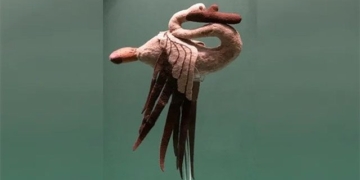Chinese scientists have announced the discovery of the gene mutation behind the rare brown-and-white panda, a unique variant of this animal considered a national treasure of China.
As of now, only seven brown pandas have been identified in China. The first was a female panda named Dandan, discovered in Shaanxi Province in 1985.

Qizai (七仔), the only brown panda in the world living in captivity. (Photo: Weibo/CCTV).
Since then, scientists have speculated about the reasons behind this color variation, as pandas are typically known to have two colors: black and white. Some believe that a genetic mutation may reduce fur pigmentation, but until now, there has been no evidence to support this theory.
On March 4, a research team from the Chinese Academy of Sciences (CAS) Zoological Center announced that they had identified a recessive gene mutation that could be responsible for the hypopigmentation condition.
The researchers analyzed the fur and genetic patterns of Dandan’s family and a 14-year-old male panda named Qizai, who was found in the wild when young and is currently the only brown panda living in captivity.
They compared the genetic makeup of these pandas with that of approximately 200 black-and-white pandas and discovered that both Qizai and Dandan carry two copies of the Bace2 gene mutation, inherited from both parents, which likely serves as the genetic basis for the brown-and-white coloration in pandas.
The authors of the study note that this research not only provides insights into why these pandas exist but also lays the groundwork for the scientific breeding of rare brown pandas.
Most pandas in China originate from Sichuan Province. For a long time, it was believed that they only had fur with distinct black and white coloring. However, to date, all brown pandas found have been located in the Qinling Mountain Range in Shaanxi Province.

According to scientists, brown pandas like Qizai have smaller skulls compared to black-and-white pandas. (Photo: Chinese Academy of Sciences Zoological Center)
Hu Yibo, a co-author of the study and a geneticist at the Zoological Institute, stated that Qinling pandas may have diverged from Sichuan pandas approximately 300,000 years ago. Additionally, these extremely rare pandas also possess smaller skulls compared to black-and-white pandas.
Both Qizai and Dandan (who passed away in 2000) exhibited normal growth and reproductive characteristics. However, the Bace2 mutation is linked to Alzheimer’s disease in humans, indicating that this mutation may have other unknown effects.


















































